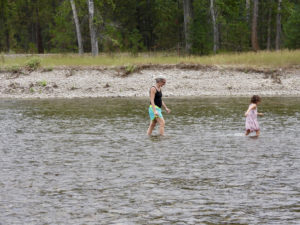
by Michael Howell
Caught under the same heat domes that have brought extremely high temperatures and drought across the West, the Bitterroot River is faring a good deal better than other rivers in the state.
Just on the other side of the Great Divide, for instance, the Upper Missouri River above Fort Peck Reservoir saw the lowest flows last month than it has in the last 123 years. According to the press release issued by the Army Corps of Engineers, the runoff this year is forecast to reach only 57% of average.
“If realized, this runoff amount would be the 10th driest year in the upper Basin since 1898,” it said in the press release.
What makes things a little better in the Bitterroot is that the river has been so severely impacted by low flows for decades that major action has already been taken to save up more water by increasing our storage capacity in Painted Rocks Reservoir and Lake Como and manage it in a way that it can last through the summer. Primary players in the ongoing cooperative effort are the State of Montana DNRC, the Painted Rocks Water Users Association, Montana Fish, Wildlife and Parks and Trout Unlimited.
J.R. Iman, former County Commissioner and President of the Painted Rocks Reservoir Water Users Association, was recently appointed to serve as the Bitterroot River Water Commissioner to replace retiring commissioner Al Pernichle. Iman said that through the dam improvements and the cooperation, Bitterrooters have managed to extend the water season for irrigators by a month and at the same time maintain river flows for the fish.
Bell Crossing is where the most crucial flow measurements are made. There is only one water diversion, out of fifty, that is diverted below Bell Crossing. All the other water is being diverted above Bell, where the river has historically run dry. When the Painted Rocks Dam was improved and heightened, both the irrigators and Fish, Wildlife and Parks got water and it is by managing it together that they try to keep the flows up at Bell.
FWP biologists determined a targeted amount of flow for maintaining a good fishery at 550 to 600 cfs. In the heat of the irrigation season, that simply can’t be met. That’s when the compromise begins and sometimes flows go lower.Bell Crossing this week
“It’s not a perfect solution,”
said Iman, “but by working together we have managed to extend the irrigation season by a month and keep as much water in the river for the fish as we can. When there is just not enough water to meet the needs of the irrigators and the fish, then everybody suffers some, but nobody goes without.” Over the last 23 years they have always managed to keep some water running for the fish.
“This is a bad year,” agreed retiring Water Commissioner Al Pernichle, who has dealt with the problem for the last 21 years. But, he said, it’s not shaping up to be as bad as he thought earlier in the summer. He said that this year, given the drought situation, they are looking at trying to maintain up to 350 cfs and have been doing pretty good.
“I’ve seen it go as low as 250 cfs to 200 cfs over the last 20 years,” said Pernichle. This year he said they’ve been able to maintain close to 400 and that on Monday it was at about 360 to 370 cfs. He does hear from a few irate outfitters every year, he says, but on the whole, everybody is pretty understanding.
The needs of the fish and the needs of the irrigators are at odds, but where there is willingness to understand and share in both the water and the overall lack of water, both sides have learned to give a little. Some have even learned to give a little more.
Trout Unlimited, for instance, has recently recognized the action of Rob and Terry Ryan who own the Roaring Lion Ranch and recently decided to forego their irrigation water for the sake of the fish this year.
Terry Ryan recently sent an email to painted Rocks Reservoir shareholders, stating: “TO ALL SHAREHOLDERS: Since this is proving to be a record dry year could those shareholders who are not planning to use their Painted Rocks water allocation or using a reduced amount write and inform the water master so he can take that decreased use into account. My husband and I own Roaring Lion Ranch with a mile on the river south of Hamilton. We are letting our pastures go dry this year to leave more water in the river to help the fish. We will therefore not use any of our Painted Rocks allotment this year. I hope other landowners will join us in this endeavor and will inform the water master of their plans. SAVE THE FISH.”
As the flows go down and the air temperature remains consistently high, the temperature of the water also rises. The Bitterroot River mainstem is currently under ‘Hoot Owl’ restrictions. The criteria for instituting Hoot Owl restrictions are water temperatures exceeding 73 degrees three days in a row, which were met on July 30, 31 and August 1. During Hoot Owl periods, the affected waters are closed to angling from 2 p.m. until 12 midnight. According to MFWP Biologist Jason Lindstrom, it is unlikely that the restrictions will be lifted until September.